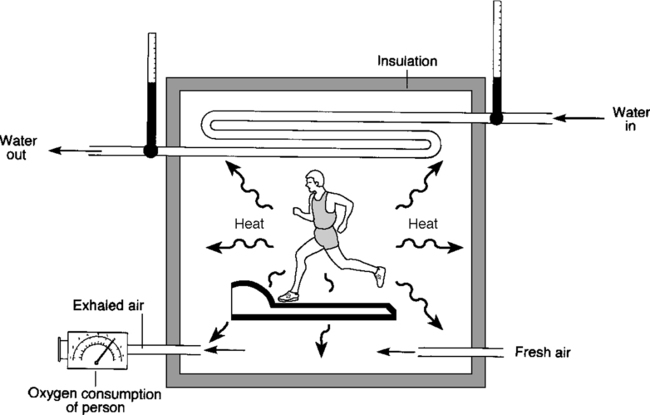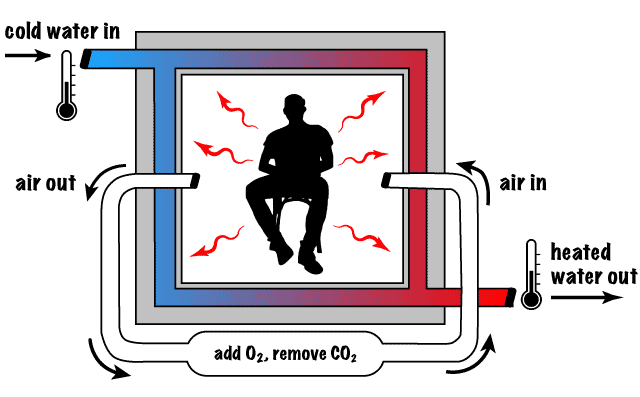Direct Calorimetry Monitors Energy Expenditure by Measuring the Amount of
This may be done under laboratory conditions in a specially designed box and is called direct calorimetry. Indirect calorimetry 3 measures the amount of inhaled and exhaled oxygen and CO 2.
Although this method is accurate the measurement is very expensive not.

. Estimates energy expenditure by measuring the amount of heat released by the body. It is the most reliable method but can only be used in laboratory conditions. It is a good measure of the energy expended while in the chamber but is not indicative of the energy expenditure of a free-living person.
One of the gold standards for the accurate monitoring of calorie expenditure is direct calorimetry which tracks and measures the specific amount of heat energy given off by the bodyHistorically the laboratory instrumentation and techniques that have been developed to carry out direct calorimetry studies are expensive and are not portable or comfortable enough. Because the energy available in food can be liberated in the body and used for the above processes only as a result of oxidations that. However it has not been possible to accurately measure all forms of heat flux in free-living humans particularly evaporative heat loss which can be a substantial component.
The produced heat can be measured in an isolated measuring chamber. Human Whole Body Direct Calorimetry obtains a direct measurement of the energy use of the body by measuring the amount of heat generated by the body. Y u Z et al Comparison of heart rate monitoring with indirect calorimetry for energy expenditure e valuation Journal of.
This work showed that the expenditure of energy by organisms can be measured directly by direct calorimeters or estimated by measuring oxygen consumption O2. Energy expenditure can be measured using one of the three approaches. Calories and Kilojoules are both measurements of energy.
There are 418 KJ in every Kilojoule so you actually did only 239 Calories worth of work. Of energy expenditure and physical activity level requires the use of measurement tools that need to take into ac - count a wide variety of human activities functions and lifestyles. Measuring Energy Expenditure.
Direct calorimetry 2 measures the heat output of a person. Indirect calorimetry is the best tool to measure and monitor energy expenditure and hence optimize the energy prescription. Direct calorimetry is the gold standard means of measuring human metabolic rate and its use has been fundamental.
Similarly to other medical techniques indications and contra-indications must be acknowledged to optimise the use of indirect calorimetry in clinical routine. Although direct calorimetry is considered. In indirect calorimetry energy expenditure is determined by measuring the amount of oxygen consumed and carbon dioxide produced.
These structures are called whole-room calorimeters. In direct calorimetry the rate of heat loss from the subject to the calorimeter is measured. To do this the body is fully enclosed in a structure.
Direct calorimetry is the measurement of heat produced by metabolic processes in the body. Indirect calorimetry is now considered the reference standard for measurement of energy expenditure in critically ill children 5. The energy expenditure thus measured can be related to net energy intake which is the energy in food minus the energy lost in urine and faeces.
1 kcal is the energy needed to increase the temperature of 1g of water by 1c ie 42 joules. Atwaters experiments measuring energy intake and energy output lasted a number of days and he was able to demonstrate consistently a fair amount of agreement between the input and the output. A measurement of the heat ouput of the body is thus also a measure of its energy expenditure.
The heat released is measured by placing a person in an insulated chamber that is surrounded by a layer of water. Coupling the measurement of body composition to that of REE expands the diagnostic potential of. The heat generated by body changes the temperature of the space which is then measured usually by changes in the temperature of water flowing through the walls.
Direct calorimetry the direct measurement of heat loss from a combustion reaction or heat emitter is the gold-standard for quantifying heat production. It measures the energy expenditure over medium periods of time hours. Direct calorimetry is considered the gold standard for measuring resting energy expenditure.
In indirect calorimetry oxygen consumption andor carbon dioxide production is measured and converted to energy expenditure using formulae12. However the human body about 24 efficient at turning food energy into mechanical energy and pedal power while the other 76 is lost as heat. Please cite this article in press as.
Whole body direct calorimetry Measurement of energy expenditure by direct measurement of the bodys heat production Sealed room sized chamber calorimeter to detect heat loss The calorie is a unit of energy. Direct calorimetry monitors the amount of heat produced by an individual in a highly sophisticated small chamber. The change in water temp is what is used to determine the heat expended.
Energy Expenditure Measured by Indirect Calorimetry in Obesity 313 necessary to know its methodological features and its theoretical and practical limitations. Indirect calorimetry 4 Figure Figure11. Indirect calorimetry measures the rate of REE the major component of the TEE.
Furthermore the various methods available for calculating daily energy expenditure possess a number of limitations. Measuring Energy Part 3. Direct calorimetry obtains a direct measurement of the amount of heat generated by the body within a structure large enough to permit moderate amounts of activity.
Its not always the most convenient method but it cuts out many of the intermediate steps involved with heat releaseparticularly when it comes to metabolism. It is also very expensive. There are 4 types of direct calorimeters namely the isothermal direct calorimeters also known as heat-flow or heat-conduction calorimeters which work by maintaining a constant wall temperature by means of a constant temperature fluid commonly water in a jacket or bath surrounding the animal chamber or in a network of copper tubing.
Direct calorimetry can be used for the assessment of energy expenditure by measurement of the bodys heat production in a calorimeter but the usual and more reliable way is to use indirect calorimetry. In humans EE is proportional to total heat loss which is the sum of conductive convective radiant and evaporative heat flows and measurement of heat loss is the basis of direct calorimetry. Direct calorimetry provides a measure of energy expended in the form of heat.
Direct calorimetry Direct calorimetry obtains a direct measurement of the amount of heat generated by the body within a structure called a whole-room calorimeter which is large enough to permit moderate amounts of activity.

Direct Calorimetry Measures Heat Production And Indirect Calorimetry Download Scientific Diagram


No comments for "Direct Calorimetry Monitors Energy Expenditure by Measuring the Amount of"
Post a Comment